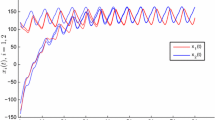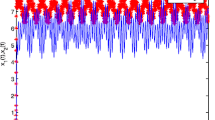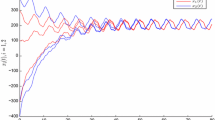Abstract
This paper investigates a class of non-autonomous cellular neural networks with mixed delays. Based on the basic theory of the weighted pseudo-almost periodic functions, several sufficient conditions are established to ensure that every solution of the addressed model exponentially tends to a weighted pseudo-almost periodic solution as \(t\rightarrow +\infty\), which generalize some existing ones. In particular, some numerical examples are also given.
Similar content being viewed by others
Explore related subjects
Discover the latest articles, news and stories from top researchers in related subjects.Avoid common mistakes on your manuscript.
1 Introduction
Recently, neural networks have gotten more and more attention because of its widespread application in a variety of areas, such as optimization problems, pattern recognition and signal and image processing [1–7]. In many practical problems, the periodic solution of the model is often required to be either globally asymptotically stable or globally exponentially stable [8–13]. In fact, there are a few pure period phenomena in nature, so the research on almost periodic phenomenon or pseudo-almost periodic phenomenon is more practical. In the past few decades, many research results have been obtained for the existence, uniqueness and stability of periodic solutions, almost periodic solutions, asymptotically almost periodic solutions and pseudo-almost periodic solutions of the following cellular neural networks (CNNs) with mixed delays [14–20]:
Here \(x_{i}(t )\) is the ith neuron state, \(a_{i}(t)\) represents the rate of decay, \({\bar{F}}_{j}\), \(F_{j}\) and \({\tilde{F}}_{j}\) are the activation of the ith neuron. The detailed biological description on the input \(I_{i}(t)\), the coefficients \(\ {\bar{\beta }}_{ij}(t)\), \(\beta _{ij}(t)\), \(d_{ij}(t)\) and delays \(\tau _{ij}(t),\) \(\sigma _{ij }(u)\) can be found in [15–17].
Most recently, as mentioned by Al-Islam et al. [21], compared with pseudo-almost periodic phenomenon, weighted pseudo-almost periodic (WPAP) phenomenon which can be accounted as an almost periodic process plus a weighted ergodic component is more frequent. As far as we know, the WPAP problem for CNNs with mixed delays has not been sufficiently studied.
Inspired by the above discussions, in this manuscript, we aim to challenge the analysis problem on the existence and exponential stability of WPAP solutions for (1.1).
2 Definitions and preliminary lemmas
Throughout this paper, \({\mathbb {U}}\) denotes the collection of functions (weights) \(\mu :{\mathbb {R}}\rightarrow (0, \ +\infty )\), which are locally integrable over \({\mathbb {R}}\) and satisfy
Define the following notations:
and
Furthermore, \({\rm BC}({\mathbb {R}},{\mathbb {R}}^{n})\), \({\rm AP}({\mathbb {R}},{\mathbb {R}}^{n})\) and \({\rm PAP}({\mathbb {R}},{\mathbb {R}}^{n})\) denote, respectively, the set of bounded and continuous functions, almost periodic functions and pseudo-almost periodic functions from \({\mathbb {R}}\) to \({\mathbb {R}}^{n}\), and
Then, \(({\rm BC}({\mathbb {R}},{\mathbb {R}}^{n}), \Vert \cdot \Vert _{\infty })\) is a Banach space with the supremum norm \(\Vert f\Vert _{\infty } := \sup\nolimits _{ t\in {\mathbb {R}}} \Vert f (t)\Vert\). A function \(f\in {{\rm BC}({\mathbb {R}},{\mathbb {R}}^{n})}\) is called WPAP if it can be expressed as
where \(h\in {{\rm AP}({\mathbb {R}},{\mathbb {R}}^{n})}\) and \(\varphi \in {{\rm PAP}_{0}^{\mu }({\mathbb {R}},{\mathbb {R}}^{n})}.\) The collection of such functions will be denoted by \({\rm PAP}^{\mu }({\mathbb {R}},{\mathbb {R}}^{n}).\) In particular, fixed \(\mu \in {\mathbb {U}}^{+}_{\infty }\), \(({\rm PAP}^{ \mu }({\mathbb {R}},{\mathbb {R}}^{n}),\Vert .\Vert _{\infty })\) is a Banach space and \({\rm PAP} ({\mathbb {R}},{\mathbb {R}}^{n})\) is a proper subspace of \({\rm PAP}^{ \mu }({\mathbb {R}},{\mathbb {R}}^{n})\) [22, 23].
According to the actual meaning, we consider initial condition
Throughout this paper, for \(i, \ j\in N,\) it will be assumed that \(\ {\bar{\beta }}_{ij }, \ \beta _{ij }, \ \ d_{ij }, I_{i}\in {\rm PAP}^{ \mu }({\mathbb {R}},{\mathbb {R}} )\), \(\tau _{ij} \in C ({\mathbb {R}}, \ [0, \ +\infty ) ), \ \tau _{ij}' \in C ({\mathbb {R}}, \ {\mathbb {R}} )\), and
We suppose that the parameters of (1.1) and activation functions in this paper satisfy the following assumptions for \(i, j \in N\).
\((E_0)\) there exist \({\tilde{a}}_{i} \in {\rm BC}({\mathbb {R}},(0, +\infty ) )\) and a constant \(K_{i}>0\) such that
\((E_1)\) \({\bar{F}} _{j}\), \(F _{j}\) and \({\tilde{F}} _{j}\) are global Lipschitz with Lipschitz constants \(L ^{{\bar{F}}}_{j}\), \(L ^{F}_{j}\) and \(L^{{\tilde{F}}}_{j}\), respectively.
\((E_{2})\) \(\sigma _{ij } :[0, +\infty )\rightarrow {\mathbb {R}}\) is bounded and continuous, and \(|\sigma _{ij }(t)|e^{\kappa t}\) is integrable on \([0, +\infty )\) for some \(\kappa >0\).
\((E_3)\) \(\mu \in {\mathbb {U}}^{+}_{\infty }\), and \({\mathbb {F}}(\alpha )=\sup \limits _{x\in \mathbb {R}}\frac{\mu (x+\alpha )}{\mu (x)}\) is bounded on arbitrary closed subinterval of \([0, \ +\infty )\).
\((E_4)\) there are constants \(\gamma _{i}>0\) and \(\xi _{i}>0\) such that
Lemma 2.1
Suppose that \(f\in {\rm PAP}^{ \mu }({\mathbb {R}},{\mathbb {R}})\), \(\vartheta \in C ^{1} ({\mathbb {R}}, \ {\mathbb {R}} )\) is almost periodic, \(\vartheta (t)\ge 0\) and \(\vartheta '(t)<1\) for all \(t\in {\mathbb {R}}\). Then, \(f(t-\vartheta (t))\in {\rm PAP}^{ \mu }({\mathbb {R}},{\mathbb {R}}).\)
Proof
Let
where \(h\in {{\rm AP} ({\mathbb {R}},{\mathbb {R}} )}\) and \(\varphi \in {{\rm PAP}_{0}^{\mu }({\mathbb {R}},{\mathbb {R}} )}.\) Clearly, \(h(t-\vartheta (t))\in {\rm AP} ({\mathbb {R}},{\mathbb {R}}).\)
In view of \((E_{3})\), we have
Letting \(z\ge 1, \ \beta =\sup \limits _{t\in {\mathbb {R}}}\frac{1}{1- \vartheta '(t)} \times \sup \limits _{\alpha \in [\vartheta ^{-}, \ \vartheta ^{+}]}{\mathbb {F}}(\alpha )\) and \(s=t-\vartheta (t)\) give us
which, together with the fact that
implies that
This finishes the proof. \(\square\)
Lemma 2.2
(see [24, Lemma 2.2]) If \(\varphi \in {\rm PAP}_{0}^{\mu }({\mathbb {R}},{\mathbb {R}} ) ,\) then, \(\int _{0}^{+\infty }|\sigma _{ij}(s)||\varphi (t-s)| {\rm d}s\in {\rm PAP}_{0}^{\mu }({\mathbb {R}},{\mathbb {R}} ).\)
Lemma 2.3
For \(~i,j\in N\), if \(x_{j}\in {\rm PAP}^{ \mu }({\mathbb {R}},{\mathbb {R}})\), then,
and
Proof
By Lemma 2.1, we have
Furthermore, let
Then, for all \(t\in {\mathbb {R}}\), we get
where \(\beta ^{h}_{ij}\in {{\rm AP} ({\mathbb {R}},{\mathbb {R}} )}, \beta ^{\varphi }_{ij}\in {{\rm PAP}_{0}^{\mu }({\mathbb {R}},{\mathbb {R}} )}, \ i,j\in N.\) Clearly,
Now, we choose constants \(\alpha _{j}\) and \(\eta _{j}\) such that
Consequently,
It follows from (2.3) that
Similarly,
Next, let \(h_{j} \in {{\rm AP} ({\mathbb {R}},{\mathbb {R}} )}\) and \(\varphi _{j} \in {{\rm PAP}_{0}^{\mu }({\mathbb {R}},{\mathbb {R}} )}\) such that
Therefore,
where \(d^{h}_{ij}\in {{\rm AP} ({\mathbb {R}},{\mathbb {R}} )}, d^{\varphi }_{ij}\in {{\rm PAP}_{0}^{\mu }({\mathbb {R}},{\mathbb {R}} )}, t\in {\mathbb {R}}, \ i,j\in N.\) In view of \((E_1)\), the definition of \({\rm AP} ({\mathbb {R}},{\mathbb {R}} )\) and Lemma 2.2, we can deduce that
and
Hence,
which, together with (2.4) and (2.5), implies that
This proves Lemma 2.3. \(\square\)
Lemma 2.4
Define a nonlinear operator G by setting
Then \(G\varphi \in {\rm PAP}^{ \mu }({\mathbb {R}},{\mathbb {R}}^{n})\).
Proof
According to \((E_{0})\) and \((E_{4})\), it is easily to see that \(G\varphi \in {\rm BC}({\mathbb {R}}, {\mathbb {R}}^{n})\) by the argument in Lemma 2.1 of [10].
From Lemma 2.3, we obtain that there are \(H_{j} \in {{\rm AP} ({\mathbb {R}},{\mathbb {R}} )}\) and \(\Phi _{j} \in {{\rm PAP}_{0}^{\mu }({\mathbb {R}},{\mathbb {R}} )}\) such that
Noting that \(M[a_{i }]>0\), using the theory of exponential dichotomy in [25], we get that
satisfies
Arguing as in the verification of [24, Lemma 2.2], one can show
Then
and
Combining with (2.7), it leads to
and ends the proof of lemma 2.4. \(\square\)
3 Exponential stability of WPAP
Theorem 3.1
Assume that \((E_0)\), \((E_1)\), \((E_2)\), \((E_3)\) and \((E_4)\) hold. Then, system (1.1) has a unique WPAP solution \(x^{*}(t)\in {\rm PAP}^{ \mu }({\mathbb {R}},{\mathbb {R}}^{n})\), and there is a constant \(\lambda \in (0, \ \min \{\kappa , \min \limits _{i\in N}{\tilde{a}}_{i}^{-}\})\) satisfying
where x(t) is a solution of system (1.1) with initial condition (2.1).
Proof
After making the following transformation,
one can show
For \(\varphi , \psi \in {\rm PAP}^{ \mu }({\mathbb {R}},{\mathbb {R}}^{n})\), in view of \((E_{0})\), \((E_{1})\), \((E_{2})\), \((E_{3})\) and \((E_{4})\), we have
which, together with the fact that \(0<\max \limits _{ i \in N}\{ 1-\frac{\gamma _{i}}{2 {\tilde{a}}_{i} ^{+}}\}<1,\) entails that the mapping G is contract, and has a unique fixed point
Furthermore, (1.1) and (3.1) imply that (1.1) has a unique WPAP solution \(x^{* }=\{x_{i}^{* }(t)\} =\{\xi _{i}y_{i}^{*}(t)\}\) .
Finally, by an almost identical proof to that of Theorem 3.2 in [26], one can pick constants \(\lambda \in (0, \ \min \{\kappa , \min \limits _{i\in N}{\tilde{a}}_{i}^{-}\})\) and \(M> \sum \nolimits _{j=1}^{n}K_{j}^{S}+1\) such that for \(i\in N,\)
and
which ends the proof of Theorem 3.1.\(\square\)
4 An example and its numerical simulations
Set
Obviously, one can select
and
such that CNNs (1.1) with (4.1) obey all the conditions mentioned in Sect. 2. Then, system (1.1) has a unique WPAP solution \(x^{*}(t)\in {\rm PAP}^{ \mu }({\mathbb {R}},{\mathbb {R}}^{2})\), and all solutions of system (1.1) converge exponentially to \(x^{*}(t)\) as \(t\rightarrow +\infty\). Here, the exponential convergence rate \(\lambda \approx 0.01\). Figure 1 gives the state response of the neural network CNNs (1.1) with (4.1) and three groups of different initial values which are \((17,-14),(-12, 15),(11,-12)\).
Remark 4.1
It is well known that the exponential stability of WPAP solutions plays an important role in describing the dynamics of differential equations. In this article, by means of the fixed point theorem and some differential inequality technique, some new criteria are derived for the existence and exponential stability of WPAP solutions of the considered model. It is also worth pointing out that the sufficient condition is simple and easy to verify. As shown above, the obtained results are improvement and extension of some previously published related results in [9–18, 24–28]. In addition, the method in this paper can also be applied to the study of other CNNs models.
References
Chua LO, Yang L (1988) Cellular neural networks: theory. IEEE Trans Circuits Syst 35(10):1257–1272
Waszczyszyn Z, Ziemianski L (2001) Neural networks in mechanics of structures and materials—new results and prospects of applications. Comput Struct 79:2261–2276
Tunç C (2015) Pseudo almost periodic solutions for HCNNs with time-varying leakage delays. Moroc J Pure Appl Anal 1(1):51–69
Liu B (2016) Global exponential convergence of non-autonomous cellular neural networks with multi-proportional delays. Neurocomputing 191:352–355
Yao L (2016) Global convergence of CNNs with neutral type delays and \(D\) operator. Neural Comput Appl. doi:10.1007/s00521-016-2403-8
Jiang A (2016) Exponential convergence for HCNNs with oscillating coefficients in leakage terms. Neural Process Lett 43:285–294
Liu X (2015) Exponential convergence of SICNNs with delays and oscillating coefficients in leakage terms. Neurocomputing 168:500–504
Mandal S, Majee NC (2011) Existence of periodic solutions for a class of Cohen–Grossberg type neural networks with neutral delays. Neurocomputing 74(6):1000–1007
Ou C (2008) Anti-periodic solution for high-order Hopfield neural networks. Comput Math Appl 56:1838–1844
Long Z (2016) New results on anti-periodic solutions for SICNNs with oscillating coefficients in leakage terms. Neurocomputing 171(1):503–509
Wang W (2013) Anti-periodic solution for impulsive high-order Hopfield neural networks with time-varying delays in the leakage terms. Adv Differ Equ 2013(73):1–15
Peng L, Wang W (2013) Anti-periodic solutions for shunting inhibitory cellular neural networks with time-varying delays in leakage terms. Neurocomputing 111(2):27–33
Gong S (2009) Anti-periodic solutions for a class of Cohen–Grossberg neural networks. Comput Math Appl 58:341–347
Xiao B (2009) Existence and uniqueness of almost periodic solutions for a class of Hopfield neural networks with neutral delays. Appl Math Lett 22:528–533
Huang Z (2016) Almost periodic solutions for fuzzy cellular neural networks with time-varying delays. Neural Comput Appl. doi:10.1007/s00521-016-2194-y
Xu Y (2014) New results on almost periodic solutions for CNNs with time-varying leakage delays. Neural Comput Appl 25:1293–1302
Liu B (2015) Pseudo almost periodic solutions for neutral type CNNs with continuously distributed leakage delays. Neurocomputing 148:445–454
Yu Y (2016) Exponential stability of pseudo almost periodic solutions for cellular neural networks with multi-proportional delays. Neural Process Lett. doi:10.1007/s11063-016-9516-z
Liu B, Tunc C (2015) Pseudo almost periodic solutions for CNNs with leakage delays and complex deviating arguments. Neural Comput Appl 26:429–435
Zhang A (2016) Pseudo almost periodic solutions for SICNNs with oscillating leakage coefficients and complex deviating arguments. Neural Process Lett. doi:10.1007/s11063-016-9518-x
Al-Islam NS, Alsulami SM, Diagana T (2012) Existence of weighted pseudo anti-periodic solutions to some non-autonomous differential equations. Appl Math Comput 218:6536–6548
Diagana T (2006) Weighted pseudo almost periodic functions and applications. C R Acad Sci Paris Ser I 343(10):643–646
M'hamdi M, Aouiti C, Touati A et al (2016) Weighted pseudo almost-periodic solutions of shunting inhibitory cellular neural networks with mixed delays. Acta Math Sci 36(6):1662–1682
Zhou Q, Shao J (2016) Weighted pseudo anti-periodic SICNNs with mixed delays. Neural Comput Appl. doi:10.1007/s00521-016-2582-3
Fink AM (1974) Almost periodic differential equations. Lecture notes in mathematics, vol 377. Springer, Berlin
Zhou Q (2016) Anti-periodic solutions for cellular neural networks with oscillating coefficients in leakage terms. Int J Mach Learn Cyber. doi:10.1007/s13042-016-0531-1
Hien LV (2016) Existence and global asymptotic behaviour of positive periodic solution of an SI epidemic model with delays. Dyn Syst. doi:10.1080/14689367.2016.1216948
Anh TT, Van Nhung T, Le Van H (2016) On the existence and exponential attractivity of a unique positive almost periodic solution to an impulsive hematopoiesis model with delays. Acta Math Vietnam 41(2):337–354
Acknowledgements
My deepest gratitude goes to the anonymous reviewers for their careful work and thoughtful suggestions that have helped improve this paper substantially. Also, I would like to express the sincere appreciation to Prof. Bingwen Liu (Jiaxing University, Zhejiang, China) for the helpful discussion when this work was being carried out. This work was supported by the Scientific Research Foundation of Hunan Provincial Education Department (Grant No. 13A093), and the “Twelfth five-year” education scientific planning project of Hunan province (XJK014CGD084).
Author information
Authors and Affiliations
Corresponding author
Ethics declarations
Conflict of interest
I confirm that I have no conflict of interest.
Rights and permissions
About this article
Cite this article
Xu, Y. Weighted pseudo-almost periodic delayed cellular neural networks. Neural Comput & Applic 30, 2453–2458 (2018). https://doi.org/10.1007/s00521-016-2820-8
Received:
Accepted:
Published:
Issue Date:
DOI: https://doi.org/10.1007/s00521-016-2820-8





